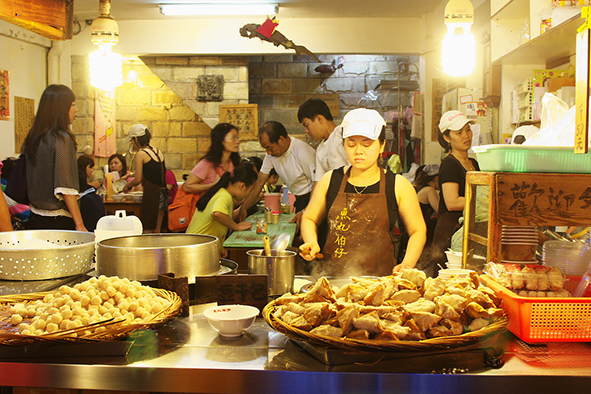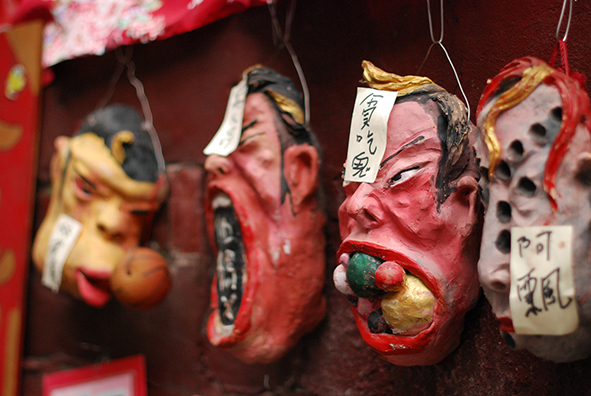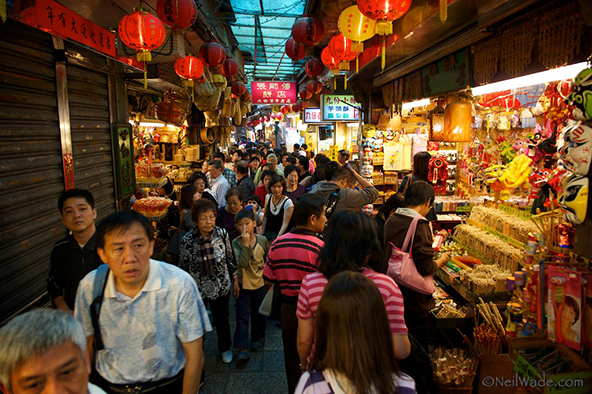On a trail of treasures in the Taiwanese town of Jiufen, the mountain town that experienced a gold rush and inspired more than one cinematic masterpiece.
It remains my most precious possession from all my travels. It is pocket sized, makes a lovely melodic noise when blown and tells a quite a story. And appropriately, I acquired this jewel in a place where treasures aplenty have been unearthed – material, cultural and historical.
Reaching our destination involved an early start and a train northwest from the bustling metropolis of Taipei. Woefully ignorant as my travel companions and I were of Taiwan before visiting, our initial expectation was of a kind of sprawling urban powerhouse; a sea of factories churning out consumer goods with no space for nature.
How wrong we were. In under an hour of travelling we were treated to a staggeringly beautiful slideshow of lush views through the glass, whizzing through thick forests, soaring over rivers and blazing through mountains. It was as if the country could sense our naivety and hurled up this spectacular rural journey to prove a point. The point was proven, but the jewel in the crown was yet to come.
The final stage of our journey involved a meandering bus journey which wound up and up through hills and valleys till we finally stopped off at the town of treasures: Jiufen
A Background of Jiufen
For centuries, just another small village nestled in the hills, it was the discovery of gold in the area in the 1890s which stimulated an influx of folk keen to make a quick buck from that universally revered shiny metal. This coincided with the colonisation of Taiwan by Japan in 1895, developing Jiufen’s industry further and resulting in it becoming a prosperous mining town under Japanese influence.
This golden age was not to last forever though. The climax of World War Two resulted in Japan being stripped of its colonies, and as a consequence the town’s gold mining industry went into decline. When the mine eventually closed in the 1970s, Jiufen faded into obscurity. The treasure trove was lost.
And so it would have remained had Jiufen’s legacy not bred a new kind of treasure: it served as inspiration for two cultural masterpieces. The first of these was A City of Sadness, a film by Hou Hsiao-hsien which touched on the tumultuous years after the cessation of the Japanese occupation, using Jiufen’s distinctive scenery as its setting. A hit in its homeland, this bolstered domestic tourism for Taiwanese keen to reconnect with their lost history. A decade later, internationally acclaimed master filmmaker Hayao Miyazaki used downtown Jiufen as inspiration for the awe-inspiringly beautiful and celebrated anime Spirited Away in 2001, encouraging Japanese and international tourists to partake in this newfound cultural gold rush.
It was this combination of its simultaneously illustrious yet melancholic past, its colourful cultural legacy and a tip-off that this town was a haven for foodies which encouraged my companions and I to take the early morning train journey to this treasure trove in northeast Taiwan.
Treasure Hunting
As soon as we hopped off the bus Jiufen delivered its first treasure, an entirely natural one that was especially pronounced on this cloudless, warm summer’s day – its sumptuous views. Jiufen looks out over undulating jade-coloured, forested slopes that eventually stretch out into the electric blue Pacific Ocean in islets and peninsulas, as if the land is breaking off into the sea. Be it in times of fortune or decline, this sight can surely never have failed to stun the varied residents of Jiufen.
The town itself clings to the steep hillside and the compression of buildings quickly compacts like a fist, within which the treasure lay.
We began our exploration with one of Jiufen’s prime draws; its warren-like, cobbled street market that snakes downward through the core of the cluttered town. Despite our early arrival, the market was already throbbing with people, mostly smartphone wielding day tripping Taipei-ites and curious Japanese tourists, although there may have been a local or two going about their daily business in amongst the fray.
This area, known as Old Street, was remarkably narrow, with higgledly-piggledy buildings huddling around on either side and everywhere there hung red paper lanterns, so ubiquitous perhaps due to the dearth of natural light penetrating the density of buildings.
I was struck by two things in here. One was an image Chihiro, the little girl and protagonist in Spirited Away, hurtling through scenery reminiscent of my current surroundings. The next was an awareness of my senses heightening in this confined space. The colours and sights and smells were pronounced and aplenty. There was food everywhere. Little ladies squatted, brandishing miscellaneous sticks of meat like fleshy skewers. Pottering through here became a kind of grazing experience. We gorged on the town’s speciality of taro balls, kurobuta sausages and, my personal favourite, ice cream sprinkled with crushed peanuts and ensnared in popiah skin, all washed down with intensely bitter, intensely green gourd juice. These exotic dishes were true local treasures – they shone like jewels and were utterly irresistible.
The restaurants and food stands were interspersed with little shops selling a variety of trinkets and charms; bespoke ceramics, jewellery, even a weird and wonderful shop showcasing a surreal and sometimes downright frightening selection of hand crafted masks.
A Treasure of Treasures
Already giddy from the sights and smells I encountered here, my ears tuned into a melody flowing underneath the hubbub of the wandering crowd. I traced the sound to its origins, and it was here I would encounter my most precious travelling possession of all.
The source of the melody was a small instrument, being played expertly yet somehow jovially by a kind eyed, long-haired shop keeper, who perhaps had found the key to a consistently happy life: to establish an ocarina emporium in rural Taiwan. He saw my open mouthed enthusiasm and invited me in, explaining that all his ocarinas were hand crafted and painted by him. They came in a range of shapes and sizes, from sapphire variations familiar to anyone who may have played the legendary Nintendo game Zelda: Ocarina of Time, to clever creations in the shapes of cats, where blowing into the tail would release its melody. There were even references to the town’s part in inspiring Spirited Away, with some of Miyazaki’s timeless anime characters available here in ocarina form.
I knew my ocarina at first sight; a sand coloured, teardrop shaped stunner, with a crescent moon and diamond pattern adorning its surface, four holes on top and two on the underside, with a colourful string fitted so it could be worn as a necklace. I purchased my treasure from the long-haired gentleman and he threw me a winning smile before proceeding to blow his next ethereal tune. Another top-notch day for the world’s happiest man.
With my new prized possession hung proudly around my neck and resting upon my beating heart, we explored the rest of the town’s treasures. The market eventually led to a selection of traditional tea houses – relics of the Japanese era – from the terraces of which that inspiring view rose once more. We took the opportunity to sit and enjoy tea here and were charmed by the friendly and quick-to-laugh elderly ladies who were in no hurry to serve the impatient tourists.
We left refreshed and came across a curious old movie theatre, a rather dusty, faded building, part of which had been restored to showcase how it had been at its peak. The information within told us this was Taiwan’s oldest cinema, again established in the Japan era. That this very movie theatre came to be used as a set in City of Sadness which in turn directly influenced the emergence of Jiufen as a tourist destination added another layer of meaning to this somewhat dilapidated cultural treasure.
Our next discovery was an abrupt open cavern and a legacy of Jiufen’s gold mining legacy; one of several tunnels that burrow through the mineral rich earth. Cold, dank and cramped and palely lit by exposed bulbs, the contrast between this and the warmth of the sun-washed teahouse terrace and the bounty of the street market was jarring, yet this tunnel was indicative of why these other facets of Jiufen existed in the first place. And the acoustics were perfect for an impromptu ocarina jam.
We emerged from the other side magically in another part of town and were greeted by a procession of schoolchildren stood in the dappled shade of a small park, singing enthusiastically out to the view beyond, where the sun was beginning to set in a blaze of reds and golds. Not far away stood the Grand Tea House, an expansive wooden building adorned with more red lanterns, which served as inspiration for the iconic Bath House in Spirited Away.
We weren’t sure why the kids were singing, but it seemed like a fitting end to our adventure in this special little town of music, mystery and treasures aplenty.






